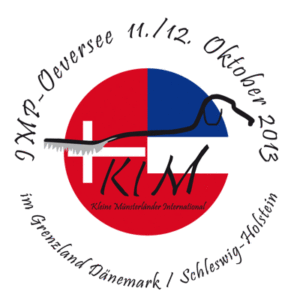INTERNATIONAL MÜNSTERLÄNDER TEST (IMP A AND B) AND INTERNATIONAL BREED SHOW FROM OCTOBER 10-12, 2013 AROUND OEVERSEE, GERMANY
(kb 01.11.13)
The organizer of this year’s International Münsterländer Test IMP A and B with International Breed Show was the Danish Münsterländer Club (Dansk Münsterländer Klub) in close cooperation with the Landesgruppe Schleswig-Holstein of the German KlM club. The test grounds were thus located on both sides of the German-Danish border.
The meeting place was the charming, quaint „Historischer Krug” in Oeversee. Altogether, 15 Kleine Münsterländer from Denmark, the Netherlands and Germany participated in the test. 10 Kleine Münsterländer participated in the IMP A (elite level) and 5 KlM in the IMP B (basic level). After words of welcome by the President of KlM-International Bernd-D. Jesinghausen and Test Director Peter W. Jürgensen with musical accompaniment by the „Jägerbläsercorps Streichmühle”, the participants moved to the fields.
As is often the case at German VGP tests, the blood tracking at the IMP A proved to be a hurdle which was difficult to overcome—also for dogs which had already passed the Association Blood Tracking Test and a VGP. The young Danish KlM bitch Horsias Rikke and her handler were impressive, with absolutely assured and composed work on the leash, and was the only KlM to receive the rating “very good” in this subject. Three KlM were unable to pass the IMP A, because they did not produce the required performance in the work on the leash.
On a large body of water with a broad belt of reeds, very good results were consistently achieved in the water work without a live duck. Most participants genuinely regretted that the work on a live, flight-impaired duck was not legally permitted. Especially a challenging breed test like the IMP A remains incomplete without an indication of passion for the water, tenacity in the water search and persistence in the work behind the hindered duck, as well as retrieving living waterfowl. The evidence for breeding potential is clearly limited.
For the field work the teams drove to Rødkro, Denmark. The individual search and search in pairs were performed in stubble and beet fields. The small fields were separated from each other by hedge rows and the small game had good cover. Partridge and hare were present in good quantities, so that the dogs could show what they had in them. A pleasure to the eyes was the search in pairs of the two bitches Quella vom Hesseltal and Horsias Rikke which crowned their performance by honoring on partridge in the beet field. If a pointing dog hunts together with another dog, and then points, it can lead to the other dog honoring the pointing dog. Although the second pointing dog doesn’t have scent in its nose, it adopts the pointing position as a reflex. This quality is genetically fixed and cannot be learned by training.
The IMP B was held for the first time, because the test regulations have been developed only recently. Above all, the goal was to gain experience with this breed test concept before final adoption of the test. The expectations, which were placed on this test at the HZP level, were fully met. All of the teams successfully completed the subjects of this multifaceted natural ability test in the forest, field and water. The handlers and judges were very satisfied and gained important experience.
The management of the International Breed Show was assumed by Karl-Heinz Sachau. 18 KlM were evaluated in two rings. The most beautiful KlM of the breed show was Axel vom Arberwald, presented by Gerhart Schäfer, and thereby obtaining a nomination to the title of “German Champion (VDH)”. The standby nomination was received by the KlM male Larcchan vom Forstweg, handled by Marjo Hagoort.
Winner of the IMP A was Bernd Weber with Quella vom Hesseltal (287 points), followed by Henning A. Petersen with Horsias Rikke (286 points) and Gunner Bertelsen with Gråsidingens Xenofon (270 points).
The IMP B was won by René Radtke with Argos vun’n Dieckslag (168 points), followed by Thomas Harm with Diva von der Leezener Au (168 points) and Bonke Häger with Arkan vun’n Dieckslag (166 points).
As a special feature of these two tests, the judges evaluated hunting intelligence, cooperation and the character of the dogs during the entire test process. The test regulations contain subjects similar to actual hunting and are designed to draw attention to dogs for international breeding. The cross-border cooperation during the test preparation and the judging were also especially encouraging.
 The festive evening event was accompanied by the „Jägerbläsercorps Streichmühle” and the „Angeliter Parforcecorps”. President Bernd-D. Jesinghausen and Vice President Henrik Raae Andersen from Denmark welcomed the President of the Landesjagdverband Schleswig-Holstein, Dr. Klaus-Hinnerk Baasch, and the Vice President of the JGHV Wolf Schmidt-Körby, who also greeted the participants of the event. Dr. Baasch, himself a long-time KlM handler, donated a hunting invitation to the best dog. Mr. Schmidt-Körby presented Henrik Raae Andersen the JGHV’s plate of honor in recognition of the good international cooperation.
The festive evening event was accompanied by the „Jägerbläsercorps Streichmühle” and the „Angeliter Parforcecorps”. President Bernd-D. Jesinghausen and Vice President Henrik Raae Andersen from Denmark welcomed the President of the Landesjagdverband Schleswig-Holstein, Dr. Klaus-Hinnerk Baasch, and the Vice President of the JGHV Wolf Schmidt-Körby, who also greeted the participants of the event. Dr. Baasch, himself a long-time KlM handler, donated a hunting invitation to the best dog. Mr. Schmidt-Körby presented Henrik Raae Andersen the JGHV’s plate of honor in recognition of the good international cooperation.
In conclusion, there was general agreement that this testing concept should be retained and further developed. It is an important and workable requirement for the advancement of international performance breeding and of cross-border cooperation.
Jacqueline Mette
